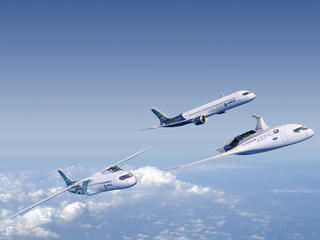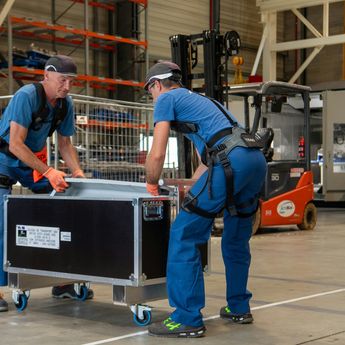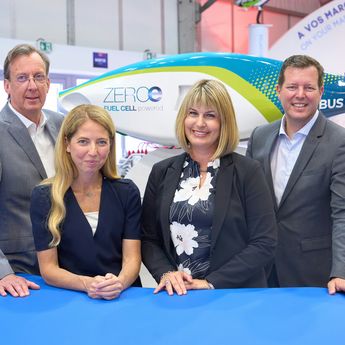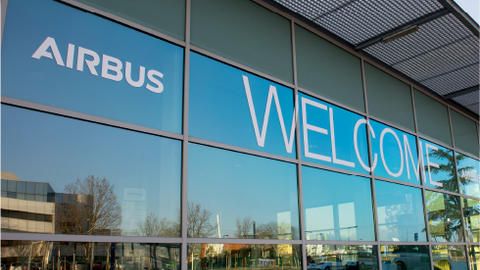- The potential for up to 900,000 tonnes of carbon emissions to be avoided every year by 2050 through use of liquid hydrogen-fuelled aircraft.
- Consortium calling for cross-party support and for the New Zealand Government to take a key role in enabling green hydrogen aviation.
A new report called ‘Launching green hydrogen powered aviation in Aotearoa New Zealand’ demonstrates how the consortium members could work together to remove up to 900,000 tonnes of carbon emissions every year by 2050 through the use of hydrogen-fuelled aircraft flying New Zealand domestic routes.
The Report has just been released by the New Zealand Hydrogen Aviation Consortium – a partnership of six international businesses Airbus, Air New Zealand, Christchurch Airport, Fortescue, Hiringa Energy and Fabrum.
Launched in February 2023, the Consortium has spent the last six months examining the hydrogen supply chain, evaluating the local aviation market’s projected hydrogen requirements, and scoping what it would take to establish a successful hydrogen ecosystem for aviation in New Zealand.
The Consortium has also developed recommendations for the regulations and incentives needed to support the transition to a green hydrogen aviation system.
Airbus is working to develop the world’s first hydrogen aircraft for commercial use.
Its ZEROe Ecosystem Vice President, Karine Guenan says New Zealand is uniquely positioned to lead the testing and deployment of low carbon aircraft.
“The country’s large potential renewable electricity and water resources are key advantages while the size of aircraft used here and the length of routes flown match the capabilities of hydrogen-powered aircraft. This report lays out the ecosystem required to make that happen. It is a first step and Airbus is committed to leveraging our expertise to work with government, iwi, industries and other stakeholders to bring it to life,” says Guenan.
Christchurch-based company Fabrum is already working on hydrogen aviation projects overseas. Its Chairman and Co-Founder Christopher Boyle says green hydrogen is an important part of the future of clean flight.
“Our team co-developed the world’s first electric aircraft engine for Magnix and built superconducting electric motors and rotors for SAFRAN and Airbus. We’re currently manufacturing green hydrogen systems for airports and on-board liquid hydrogen tanks for low emission flights. The opportunity to use our experience to ensure green hydrogen aviation takes off in New Zealand is exciting.”
Air New Zealand Chief Sustainability Officer, Kiri Hannifin says the Report provides information that could be used to build out a blueprint for hydrogen-powered aviation in New Zealand.
“Air New Zealand is committed to decarbonising its operations. Green hydrogen fuelled aircraft is one of the potential levers we have available to us. This report provides important proof points for both the aviation sector and decision-makers to work together to make that happen.”
The Report shows that to enable green hydrogen aviation to take-off, New Zealand will need to:
- Scale affordable new generation renewable energy in New Zealand to support the production of green hydrogen.
- Develop the transmission and distribution capacity to move that renewable electricity to where it is needed
- Develop policies and regulations to create and support a green hydrogen ecosystem.
- Develop a range of new systems and processes to ensure the safe production, distribution and use of green hydrogen.
- Become more cost-effective to produce and supply green hydrogen to ensure its commercial viability.
The Consortium’s modelling shows New Zealand could use up to 100,000 tonnes of green hydrogen per year for hydrogen-fuelled aircraft by 2050 with most of it required to fuel planes at Auckland, Wellington and Christchurch airports.
Christchurch Airport General Manager Future Planning and Sustainability Nick Flack says up to 6,700-gigawatt hours of renewable energy will be required to generate that green hydrogen.
“That’s up to 16% of New Zealand’s current total electricity supply. That demand presents an opportunity for businesses. We’ve now committed to progressing a hydrogen hub as part of our 400-hectare renewable energy precinct, Kōwhai Park. Twenty other airports around the world are doing the same,” says Flack.
Fortescue’s Global Aviation Lead Amy Barrett says while establishing green hydrogen aviation in New Zealand will be challenging, the report indicates it’s a practical and implementable solution.
“Aviation, like our own iron ore operations, is one of the hard-to-abate sectors. Hard-to-abate doesn’t mean impossible to decarbonise – it just requires a lot of effort and long-term commitment. It also needs collaboration, and that’s what we are doing here, we know we need to work together to find the best solutions.”
Hiringa Energy Chief Executive, Andrew Clennett, says the report highlights the need to have physical and regulatory infrastructure in place to enable low emission aircraft to be trialled and deployed in New Zealand.
“Green hydrogen is integral to the decarbonisation of New Zealand’s domestic aviation network, and why it made perfect sense for Hiringa to join the consortium. By sharing our first-hand technical, operational and commercial expertise, we hope to accelerate New Zealand’s already thriving green hydrogen landscape, and lead the world in the transition to clean aviation.”
*based on new vehicles driving 10,000 kilometres per year.
You can find the New Zealand Hydrogen Aviation Consortium’s report here.
About green hydrogen aviation
For airlines to meet their ambitions to achieve net zero carbon emissions by 2050, they need to phase out the use of fossil fuels.
Green hydrogen is one of the potential solutions the global aviation sector is planning to use to achieve that ambition. Others include Sustainable Aviation Fuel (SAF) which can cut emissions by up to 80%, electric, battery-electric aircraft, infrastructure and operational efficiencies, and offsets and carbon capture.
Fuelling transport with green hydrogen helps reduce greenhouse gas emissions. It’s already being used to fuel cars, buses, trucks and boats (including professional sailing team Emirates Team New Zealand’s America’s Cup chase boat, Chase Zero).
Hydrogen fuel cells have been successfully trialed to power aircraft overseas. The next step is to design technology to enable liquid hydrogen, which is more energy dense and easier to transport than gaseous hydrogen, to power aircraft.
Hydrogen-powered technology will likely be best suited for medium-sized aircraft seating 20 to 200 passengers and flying distances from around 200 to 2,000km and potentially up to around 3,500km.
Air New Zealand
Air New Zealand's story started in 1940, first taking to the skies between Auckland and Sydney on a flying boat.
Known for its warm Kiwi hospitality, today the airline has 106 operating aircraft ranging from Boeing 787-9 Dreamliners and Airbus A320s to ATRs and Q300s.
Air New Zealand has a well-connected domestic business, connecting customers and cargo to 20 different regions around New Zealand.
Internationally, the airline has direct flights to major cities across Australia, Asia, the Pacific Islands and the U.S., and through its strong relationships with alliance partners, offers customers more choice and convenience to connect further afield to hundreds of destinations.
Air New Zealand has a particular focus on sustainability and its Sustainability Framework helps guide the airline's efforts in tackling some of New Zealand's and the world's most complex challenges.
Website: airnewzealand.co.nz/about-air-new-zealand
Airbus
Airbus pioneers sustainable aerospace for a safe and united world.
The Company constantly innovates to provide efficient and technologically-advanced solutions in aerospace, defence, and connected services.
In commercial aircraft, Airbus offers modern and fuel-efficient airliners and associated services.
Airbus is also a European leader in defence and security and one of the world's leading space businesses.
In helicopters, Airbus provides the most efficient civil and military rotorcraft solutions and services worldwide.
Website: airbus.com/en/innovation/energy-transition/hydrogen/zeroe-our-hydrogen-powered-aircraft
Christchurch Airport
Christchurch Airport has been recognised as a global leader in sustainability.
In 2020 it became the first airport in the world to reach the highest level of decarbonisation under the Airports Council’s International’s carbon accreditation programme.
Its greenhouse gas emissions have been independently audited every year since 2006 with Scope 1 emissions (those under its direct control) now nearly 90% lower than 2015 levels.
The airport’s sustainability approach is science-based with targets set to ensure it decarbonises at a rate that will keep global warming to 1.5 degrees (the target enshrined in the Paris Agreement). It is currently 14 years ahead of where it needs to be.
It measures the terminal’s water and energy use in real-time to ensure it is continually operating at optimal efficiency.
Enabling other businesses, particularly its airline partners, to decarbonise is a key focus and the airport is developing a renewable energy precinct, Kōwhai Park, to provide the green energy the new generations of electric and hydrogen aircraft will require.
Website: christchurchairport.co.nz/about-us/
Fabrum
Fabrum was founded in Christchurch (NZ) in 2004 by Christopher Boyle and Hugh Reynolds.
The company has a long history of innovation, precision engineering and delivering solutions that support sustainable existence.
Over its near 20-year history Fabrum has worked on a variety of high-profile projects – it collaborated with NASA on a Liquid Air life support package for astronauts and a CO2 sublimation project for the Mars lander program; with Rolls Royce to develop superconducting systems and has recently developed hydrogen-powered drive trains for Team Emirates New Zealand’s Chase Zero boat.
Fabrum has a strong background in aviation that includes projects to decarbonise the industry. It co-developed the world’s first electric aircraft engine for Magnix and built superconducting electric motors/rotors for SAFRAN/Airbus.
The company is currently manufacturing green hydrogen systems for ground-based infrastructure at airports and also on-board fuel tanks to carry liquid hydrogen for zero emission flights.
Website: Fabrum.nz
Fortescue
Fortescue is a global metals and green energy company, recognised for its culture, innovation and industry-leading development of infrastructure, mining assets and green energy initiatives.
Fortescue is committed to producing green hydrogen, containing zero carbon, from renewable electricity.
Green hydrogen is a zero-carbon fuel that, when used, produces primarily water. It is a practical and implementable solution that can help revolutionise the way we power our planet: helping to decarbonise heavy industry and create jobs globally.
Fortescue is leading the green industrial revolution, acquiring and developing technology solutions for hard-to-decarbonise industries, while building a global portfolio of renewable green hydrogen and green ammonia projects.
Fortescue, one of the world’s largest producers of iron ore, is also leading the global effort to help decarbonise hard-to-abate sectors and is developing and acquiring the technology and energy supply to help decarbonise its Australian iron ore operations by 2030 (Scope 1 and 2 terrestrial emissions).
Website: fortescue.com
Hiringa Energy
Headquartered in Taranaki (New Zealand) Hiringa Energy is a group of energy professionals with a passion to make a global difference and address climate change.
Our mission is to supply the world with zero emission hydrogen.
Hiringa Energy produces zero emission green hydrogen and is developing the infrastructure necessary to deliver it.
One of the great hurdles to the adoption of any new fuel is a reliable supply network.
Hiringa Energy is building a high-capacity green hydrogen re-fuelling infrastructure across New Zealand with the first four stations under construction in Hamilton, Palmerston North, Auckland and Tauranga.
These will be operational in 2023 and our plan is to have 100 stations throughout New Zealand by 2030.
Website: Hiringa.co.nz
Consortium lays pathway for green hydrogen aviation to take flight in New Zealand.
Download
Documents
Consortium lays pathway for green hydrogen aviation to take flight in New Zealand.

ZEROe Concept Aircraft Formation Flight
Documents
Consortium lays pathway for green hydrogen aviation to take flight in New Zealand.

ZEROe Concept Aircraft Formation Flight
Your media contacts
Contact us
Belinda Ng
AIRBUS | Asia-Pacific
Ben Spencer
Fortescue
Maja Markun
Fabrum
Ryan McDonald
Hiringa Energy
Yvonne Densem
Christchurch Airport
Jan McIntyre
Air New Zealand
Innovation latest news
Continue Reading

Airbus and partners complete successful wake energy retrieval trials
Press Release
Innovation
Airbus and partners complete successful wake energy retrieval trials
Combating information warfare: How Airbus is helping win the fight for the truth
Web Story
Defence

Powering production and protecting people with exoskeletons
Web Story
Innovation

Airbus and MTU Aero Engines advance on hydrogen fuel cell technology for aviation
Press Release
Innovation
Airbus and Critical Software explore strategic partnership in embedded software…
Press Release
Innovation

